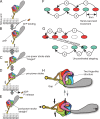Big steps toward understanding dynein
- PMID: 23836927
- PMCID: PMC3704981
- DOI: 10.1083/jcb.201304099
Big steps toward understanding dynein
Abstract
Dynein is a microtubule-based molecular motor that is involved in various biological functions, such as axonal transport, mitosis, and cilia/flagella movement. Although dynein was discovered 50 years ago, the progress of dynein research has been slow due to its large size and flexible structure. Recent progress in understanding the force-generating mechanism of dynein using x-ray crystallography, cryo-electron microscopy, and single molecule studies has provided key insight into the structure and mechanism of action of this complex motor protein.
Figures





References
Publication types
MeSH terms
Substances
LinkOut - more resources
Full Text Sources
Other Literature Sources

